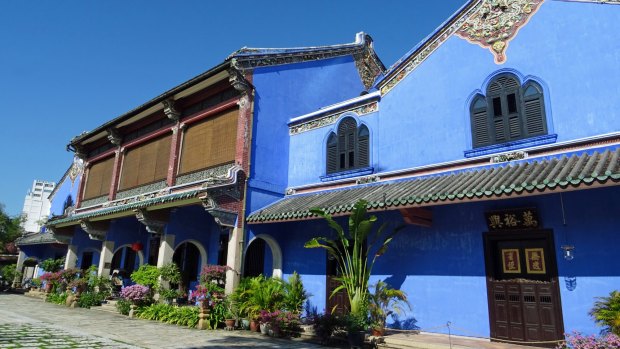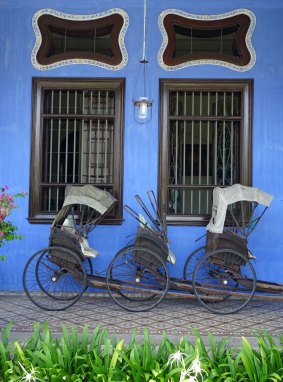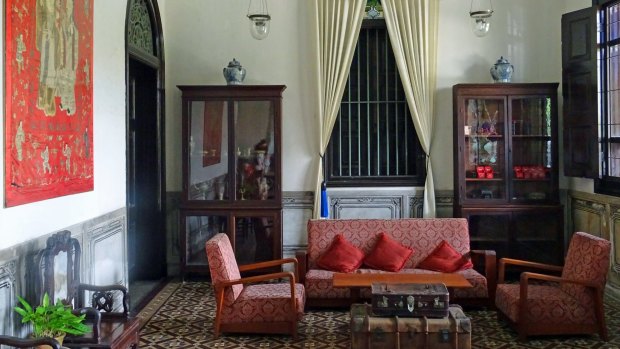This was published 6 years ago
Cheong Fatt Tze Mansion (The Blue Mansion): The most atmospheric Chinese hotel that isn't in China

Cheong Fatt Tze Mansion won awards for its renovation as a boutique hotel.Credit: Brian Johnston
I wish I'd brought my opium pipe and eunuch with me. Cheong Fatt Tze Mansion isn't really that old, but it feels invested with a thousand years of history and feng-shui lore. It evokes all kinds of fantasies of secret societies, caged songbirds and concubines. (The quarter beyond the compound did indeed once housed decommissioned concubines, and is now occupied by a row of spice-reeking street eateries.) Fashion magazines shoot models here in cheongsams and chopsticks.
On a continent in which hotels often either still smell of drying paint or feature European colonial decor, this indigo-coloured mansion is a wonderful anomaly. Even more so since it has no spa, no room service and no airconditioning in public areas, which feature a series of open courtyards. It was built as a private mansion by Chinese politico, imperial economic advisor and self-made "Rockefeller of the East" Cheong Fatt Tze, who was obsessed with both traditional feng shui and quality work.
This architectural beauty lingered on in the family, getting increasingly dishevelled, until 1989 when a conservancy group took over and the mansion eventually re-emerged as a boutique hotel, bagging all kinds of renovation-rescue awards in the process.

Rickshaws outside the Cheong Fatt Tze Mansion Hotel.Credit: Brian Johnston
To its credit, the hotel runs guided tours three times daily so that non-residents can see this blue architectural gem and learn about its remarkable owner. Two rooms are set aside as a mini-museum displaying Cheong family memorabilia, including shimmering silk cheongsams owned by Cheong's diminutive young seventh wife, who considered this house her favourite.
The Blue Mansion, as it's nicknamed, is a marvel of tranquil courtyards, Chinese carved screens and porcelain, and is one of the best-preserved such mansions outside China. This being Malaysia, though, other influences subtly intrude, such as art deco stained glass, English floor tiles and Scottish cast-iron balustrades. Plaster arabesques on the ceiling are an idea import from British India.
The mansion's restaurant, Indigo, has a smart contemporary interior and east-west fusion dishes. Even if you don't stay, go for dinner. Penang-raised chef Beh Weng Chia has worked in Australia, Japan and America and really knows what he's doing. The seafood is terrific: grilled prawn and squid salad, grouper with torched octopus, Hokkaido scallops with squid-ink capellini pasta. The spiced, honey-glazed duck with taro puree and orange-hoisin sauce will make you lick your knife. Desserts use local ingredients such as mango, jasmine and jackfruit in western classics such as crumbles and panna cottas.

The entrance hall, Cheong Fatt Tze Mansion Hotel.Credit: Brian Johnston
Breakfast in the main courtyard is an altogether more laidback affair. Fans stir Penang's humidity and potted plants droop. If a tropical shower develops, water gurgles down drainpipes and along stone channels in the flagstone courtyard, bringing instant coolness. You can see the rise in the floor supposed to "ride the dragon's back" according to feng-shui principles.
The house is shadowy around you. You feel the ghost of Cheong Fatt Tze might come shuffling along in embroidered slippers. Instead a flip-flopped waiter will dish you up omelette and roti in another of those east-west combinations in which Malaysia so endearingly specialises.
There are only 18 rooms and all are different. They aren't luxe – this isn't a hotel for the Molton Brown and thousand thread-count brigade – but they have plenty of character, some with ornate Chinese bedheads in a riot of gold paint, and plenty of the old-style Chinese cupboards, calligraphy boards and wooden armchairs that have now become so fashionable everywhere.
TRIP NOTES
MORE
FLY
Malaysia Airlines flies from Adelaide, Darwin, Melbourne, Perth and Sydney to Kuala Lumpur, with onward domestic connections to Penang. Phone 13 26 27, see malaysiaairlines.com
TOUR
George Town guides can be booked through Penang Heritage Trust, a non-profit NGO dedicated to the preservation of Penang. Premium heritage walks cost around $60 per person (minimum of two people). Phone +60 4 264 2632, see pht.org.my
STAY
Cheong Fatt Tze Mansion sits within easy walking distance of historical George Town, with rooms from $140. Non-residents can join the 45-minute daily tour for RM 17 ($5.60), or dine at Indigo restaurant. Phone +604 262 0006. See cheongfatttzemansion.com
Brian Johnston travelled as a guest of Malaysia Airlines, Tourism Malaysia and Cheong Fatt Tze Mansion.
Sign up for the Traveller Deals newsletter
Get exclusive travel deals delivered straight to your inbox. Sign up now.